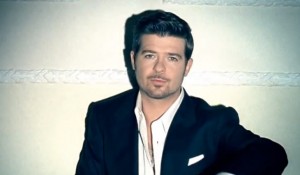
Robyn Thicke may have started some controversy with "Blurred Lines" - Having fake followers will be worse for your business (Image source: Robyn Thicke Google Plus Page)
Robin Thicke was controversial with his hit song "Blurred Lines". But manufacturing fake fans and followers can be just as controversial to your customers and a severe detriment to your business. The marketplace for fake fans stems from a combination of small businesses trying to socially engineer their importance - the fake it until you make it syndrome. It is also a technological evolution of the fake link era that plagued early websites (see this Zimana post on why bad links are, well, bad). Also, social media is becoming a strong influencer of purchasing decisions. eMarketer, for example, noted how consumer reviews in social media are more highly considered than that from critics. So the temptation to social engineer favorable images about one's business is high. There are many people who think buying fake followers is acceptable. But it's anti-analytic. And there are more than a few good reasons why buying a bunch of fake followers is an awful choice for your brand and can turn off customers.
- First the anti-analytic part: It will damage your reporting - your metrics will be meaningless because the sources are fake. Part of analytic value comes from paying attention to metrics. Instead, businesses will ignore analytic practices that are now an essential part to operating success.
- Fake followers calls the credibility of your business into question - who wants to be associated with fake followers? Not honest customers.
- Engagement can not be faked - customers will identify when your pages are full of inactivity and will ignore your messages in the long run.
- Social media platforms are evolving their policing of fake followers. For example, Twitter says they monitor inactive or suspicious accounts and eliminate them after 3 or 4 months. As a result, more than 70% of the accounts will be invalidated at some point. This means that your number of followers will decrease drastically, raising suspicion. In most cases, this will have a negative effect on your brand.
The problem looks like it will continue on. Gartner noted in a report that by 2014 1 out of 10 reviews, likes, or followers will be fake. The Next Web also reported how thousands of business are buying followers.

Click on the Total Likes of a Facebook Page: You'll see a summary like this one. No activity is a sign of potentially bought likes.
There are a few steps businesses can use to avoid "blurred lines" when it comes to genuine customer engagement.
- Establish a social media manager who can administrate analytics and identify a list of trusted referral traffic sources – essential for linking to highly regarded sites ad extending communication to valued partners
- Examine referral sources by returning traffic - this should indicate that you have repeating visitors and are less likely to be bots if the time spent on site or on page makes sense (more than a few seconds).
- Decide how to link offline event or marketing into your online presence. Create real traffic from your encounters. The people who join your Facebook page or Twitter feed can become advocates if they like how you handle your social media in addition to liking their offline encounter with you.
- Research online communities to see if they are worth deepening a connection. See if the posts contain “natural” responses to the topics or repeated spam, aggregators or comments.
- Consider tools such as Satuspeople.com to examine Twitter followers – This shows if partners and followers really have cultivated a true audience or bought their way to scale. The site indicates if a Twitter feed is False, Inactive, or Good.

